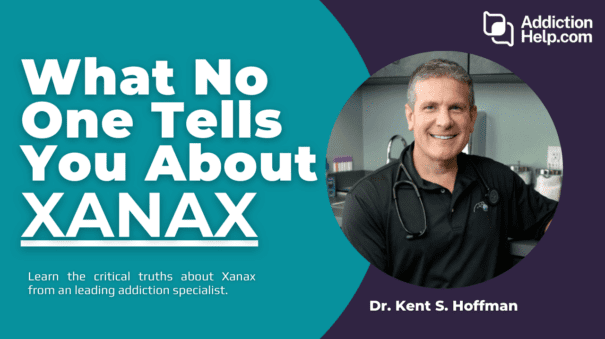Xanax Addiction
Xanax (alprazolam) is highly effective in treating anxiety and panic disorders when used as prescribed, but it can also be highly addictive—especially when abused. Learn more about the signs and symptoms of Xanax addiction, the potential risks and side effects of long-term Xanax use, and the treatment options available for individuals struggling with Xanax dependence and addiction.
Battling addiction and ready for treatment?
What Is Xanax?
Xanax® is the brand name for the prescription drug alprazolam and belongs to the family of benzodiazepines.
Like all benzodiazepines, Xanax is an FDA-approved treatment for certain mental illnesses, particularly anxiety disorders (e.g., generalized anxiety disorder, panic disorder, PTSD, etc.)
However, doctors may also prescribe Xanax for insomnia, alcohol withdrawal, and pre-surgery sedation.
Xanax is one of the most widely available prescription medications in the United States, with an estimated 15.4 million Americans taking Xanax in 2021 as prescribed by their doctor.
How Does Xanax Work?
Xanax works by creating a tranquilizing effect on the central nervous system (CNS), encouraging muscle relaxation and lowering anxiety levels. Scientists believe that excessive nerve activity may be the cause of anxiety and other mental disorders.
Studies have shown that benzodiazepines like Xanax affect a neurotransmitter that controls suppressing your nerves (i.e., your GABA-a receptors). Xanax works quickly to target this part of your brain, inducing feelings of calm and sometimes sedation.
Xanax is designed to take effect quickly, and as a result, people who abuse Xanax may take it due to how fast they feel its effects.

In this informative video, Dr. Kent Hoffman, co-founder of AddictionHelp.com and a physician board-certified in addiction medicine, delves into the complexities of Xanax. View Transcript.
Duration: 15 min 03 sec
[00:00:00] Dr. Hoffman: My name is Dr. Kent Hoffman. I’m an osteopathic physician. I’m board-certified both in addiction medicine and family practice. I have been board-certified in family practice for about 30 years, and I’ve been board-certified in addiction medicine for about 13 or 14 years now, and I’ve been practicing addiction medicine for approximately 20 years.
[00:00:25] What Xanax is typically prescribed for would be anxiety panic disorders. Um, and technically, it’s a benzodiazepine. So it falls within the sedative-hypnotic class of drugs. Way back in the day, benzodiazepines were actually what they thought to be a very much safer alternative to barbiturates.
[00:00:45] They Were kind of, which were their precursors in the sedative-hypnotic class. And I think the first one was Librium, which is chloridase epoxide. That was initially brought to the market in about 1960. Now we [00:01:00] predominantly use it for alcohol detox and things like that. It’s not used so much because it has such a long half-life.
[00:01:08] It’s a period of time that the medication, there’s half of it left in your system. So they’re much, uh, shorter, you know, cleaner drugs, uh, if you want to look at it that way. There’s, uh, several off-label uses that Xanax is prescribed for, and those would be things like, uh, seizure disorder, perhaps. They use it sometimes as a preoperative medicine, although typically, Valium, Versed (midazolam)would be used for those things.
[00:01:42] Benzodiazepines prior to surgeries and, or procedures would be, helpful in calming people down, but they also act synergistically with some of the narcotic medicines such as, uh, pain medications. For example, with, uh, Colonoscopy is one of the common [00:02:00] cocktails would be Versed (midazolam), which has kind of an amnesiac effect and calms you down.
[00:02:06] And then either fentanyl or, you know, one of the other opioid medications. Xanax actually within the body stimulates the GABA receptors. And GABA is like our brain and our body’s natural valium. And so by stimulating these receptors, it gives you, you know, a valium like response. That would be, you know, you’d be more chill, more relaxed, less anxious.
[00:02:34] If you’re taking the Xanax consistently and, you know, with prolonged use, you will develop tolerance. And so, whereas initially, A given dosage might, uh, you know, really chill you out or put you to sleep, even sedate you, uh, later on, you’ll notice very few effects. Um, again, it depends on how high the anxiety level is compared to how high the dosage is.[00:03:00]
[00:03:00] And if you meet those two, then you shouldn’t get a lot of sedation with the medication. If, however, you’ve had very little anxiety, and you’re taking a high dose of Xanax. Well, then you’re going to be very sedated. If you’re wondering what Xanax looks like with the generic medications in this day and age, it can honestly look in a variety of shapes.
[00:03:22] And historically, the lower doses were round tablets. The one milligram was football-shaped, so the kids on the street would call them footballs. Then, the two-milligram divi dose bar is shaped like a bar with four demarcations in it. So you can break it to one milligram, you can break it to a half milligram, or one and a half milligrams.
[00:03:54] And on the street, the kids call those, uh, you know, ladders, school buses, bars, a variety of things. For a safer alternative, moving out of the benzodiazepine class, which are all potentially addictive, moving to either a longer half-life benzodiazepine, something like a Librium, or, you know, some people consider Klonopin to be safer.
[00:04:20] I’m not sure I believe that so much, but, uh, otherwise, there’s a variety of other medications, uh, SSRI drugs that can be used for, um, Anxiety, which are things like, uh, Zoloft and Prozac and Paxil or, uh, medications, uh, you know, such as Gabapentin has been used for anxiety. Buspar is a nonnarcotic medication, a nonaddictive solution to anxiety.
[00:04:50] So there are a lot of different medications that might be safer to use for anxiety. There are some people who take Xanax every day and use it long-term. [00:05:00] Uh, I think its greatest benefit would probably be as a short-term medicine for acute situations. A death in the family, seeing something extremely traumatic, maybe a car accident, things such as that.
[00:05:16] Because it has a pretty much immediate onset. And about a six-hour half-life. So, uh, it’s potentially, you know, our brain likes anything that takes off very quickly. Kind of like Learjet, much more than something that takes off slowly like a 747. Xanax starts at dosages as low as 0. 25 milligrams.
[00:05:39] Then there’s 0. 5 milligrams. Then there’s 1 milligram. And then finally, 2mg, the bars or the school buses, as we mentioned. So, 1mg is a relatively high dose, and of course, it depends on how many times a day you take it. So as far as overdose is concerned, Xanax, [00:06:00] uh, certainly, depending on what your tolerance is, um, doses as low as, you know, 4 or 6mg would perhaps cause an overdose.
[00:06:10] In general, the benzodiazepines, In and of themselves, when only taken by themselves, uh, cause rare, infrequent overdoses. It’s more common that they’re a, uh, part of a cocktail of drugs that will cause an overdose. You know, trying to take the edge off of cocaine. Uh, the cocaine high or, um, adding it to, uh, either alcohol, which is liquid benzodiazepine as far as our brain’s concerned, or otherwise opiates, which will increase the, uh, opioid levels.
[00:06:49] When I talk about alcohol being a liquid benzodiazepine or. The benzodiazepine being alcohol in a pill, um, they affect the exact same [00:07:00] GABA receptor in the brain. So, really, your brain can’t tell whether you just took a Xanax or an Ativan or whether you just did two shots of tequila. And the withdrawal is very much similar in both drugs, the, you know, alcohol and benzos.
[00:07:19] So the benzodiazepine and alcohol withdrawal are considered, in general, uh, some of the most potentially life-threatening withdrawal processes, because you can have things like seizures, uh, hallucinations, and then ultimately the DTs, which is the delirium tremens. And that’s really an ICU-like condition.
[00:07:41] So with any of the benzodiazepines, you definitely want to. Figure out what your tolerance was. If you were started on one of these medicines, I wouldn’t recommend driving or taking other medications and certainly not drinking alcohol with it because it’s just going to be amplified in [00:08:00] this effect. So you definitely would want to figure out, you know, what it does to you and how much it impacts you before you’d want to do any of the kind of normal lifetime activities, like take care of your kids or, you know, drive to work or drive them to school.
[00:08:16] Some of the side effects that are common to Xanax would be, you know, first of all, sedation. If you take a higher dose than you need for, say, anxiety, or if you’re taking it recreationally, um, certainly sedation is going to be a major side effect. Um, it’s not going to help, uh, sexual performance, certainly.
[00:08:37] Uh, otherwise, really it’s mostly sedation and, uh, you know, those types of side effects. It’s discouraged to take it while pregnant or breastfeeding because it’s actually, uh, can potentially have adverse effects on the baby. And of course you wouldn’t want to breastfeed while you’re on it because your baby, [00:09:00] um, could get some of the medication.
[00:09:02] It can certainly lower blood pressure. Um, the benzodiazepines in general, one of the potential side effects or adverse effects. is hypotension, uh, which is lowering of the blood pressure. In general, there are actually multiple studies that have looked at people who’ve been on the long-term benzodiazepines.
[00:09:22] I think the average was about 10 years and they showed that the cognitive abilities, uh, speech, uh, recall, you know, a variety of the, you know, what we call the executive function centers of the brain perform much more poorly. So it makes you kind of stupid. The whole family of benzodiazepines, as you can imagine, it is a family, but just like family members, um, each one is a little bit different.
[00:09:50] they’re a little bit different with respect to, um, how fast they take action, you know, their onset. They’re also different in as far as how [00:10:00] long they last, their half lives. So you can imagine that with a benzodiazepine that’s made to, for a sleeping pill to put people to sleep, it’s going to have to have very fast action and a relatively short half-life.
[00:10:15] With Xanax or other benzodiazepines, especially the short-acting ones. People can have withdrawal symptoms after being on it for just a couple of months. Most people will have withdrawal symptoms if stopping it abruptly if they’ve been on it for a year or longer. And again, getting back to the fact that benzodiazepine withdrawal and alcohol withdrawal are two of the most dangerous withdrawals to go through.
[00:10:42] You don’t want to stop these things cold turkey if you’ve been on them for any length of time, meaning months to years. So, Xanax is a drug of abuse because of its rapid onset and relatively short half-life. That’s what our brain likes, anything that takes off quickly and [00:11:00] impacts us quickly, especially when it’s combined with other, uh, drugs or alcohol.
[00:11:06] So people, uh, like the feeling of, uh, you know, being sedated, being down. Uh, sometimes they like The fact that, uh, it takes the edge off of cocaine or meth or other stimulants, Adderall. When combined with alcohol, you don’t have to be on much Xanax or drink much alcohol in order to be in blackouts. It’s almost a guaranteed blackout.
[00:11:33] Where you’ll be functioning, it’ll look like you’re just fine. Where the light’s on, and there’s nobody home. You know, you don’t remember it the next day. Typically they would abuse Xanax by taking it orally, snorting it. Um, rarely is it used IV. I just haven’t seen that a lot. Mostly, it’s an oral or [00:12:00] nasal insufflation, i.
[00:12:00] e. snorting it. One of the sure signs that you’re dependent Xanax is going to be that if you miss a day, or if you can’t get it off the street, or if your prescription runs out and you start to feel shaky and clammy and, uh, you know, antsy, those are all signs of early withdrawal for the benzodiazepines.
[00:12:26] And then it goes on to seizures, hallucinations, or at least potentially to seizures, hallucinations, and the DTs. Traditionally, when we do medication-assisted withdrawal, Aka detox, we use longer-acting benzodiazepines and try to bring them down slowly because, again, our brain likes anything that takes off quickly and is short-acting.
[00:12:51] So when we use longer acting benzodiazepines, things like Librium, uh, it helps to bring the brain in for a smooth landing. [00:13:00] Essentially, we use the same medications. To do detox from benzodiazepines, as we do from alcohol use, the thing that makes any treatment that just brings the brain in for a smooth landing.
[00:13:11] So people don’t have seizures, uh, hallucinations, other symptoms and withdrawal. So we try to get them to survive the early detox, but then really the heavy lifting is done and counseling group meetings, uh, AA, NA, things like that. A lot of people ask, how long does it take to detox from things like Xanax or other benzodiazepines?
[00:13:39] And it really depends on how short acting it is and the amount that people are taking. Again, if you’re on very low dose, it doesn’t take nearly as long. Or if it has a longer half-life, it doesn’t take as long to detox somebody. So the higher the dose, the shorter the acting, the [00:14:00] longer it’s going to take, um, to do detox, especially if you do that as an outpatient.
[00:14:05] Well, the most successful, uh, you know, programs for people who are addicted to Xanax would be, um, to use, to do an inpatient, uh, detox or an outpatient detox if they were an applicable candidate. And then go on from there and be able to do counseling. Potentially, uh, Inpatient treatment, um, especially if they were on very high doses where it would be dangerous or if they had ever had, previous Benzo withdrawal seizures, then it would be very dangerous to try to detox them as an outpatient.
[00:14:45] So you’d want to detox them as an inpatient and then frequently they would go on to their either a residential program, um, or say an IOP program.[00:15:00]
[00:15:03]
Xanax Abuse
Benzodiazepines like Xanax are often abused due to their fast-acting effects and widespread availability. Unfortunately, even regular use of Xanax can lead to abusing the drug—and potentially, to dependence and addiction.
Some warning signs of Xanax abuse include:
- Taking more Xanax than prescribed
- Taking Xanax for reasons other than medically prescribed
- “Doctor shopping” (i.e., getting scripts from multiple doctors) to take more Xanax
- Combining Xanax with other drug use (including alcohol!)
- Needing a higher dose to achieve the same effect (i.e., tolerance)
- Experiencing withdrawal symptoms when not taking Xanax
Over time, a person abusing Xanax—whether they started out using it medically or not—has a high chance of developing physical dependence and Xanax addiction.
Warning Signs of a Xanax Addiction
Drug addiction affects people from all walks of life, and Xanax addiction is no different.
Overall, a person dealing with any type of substance use disorder will begin to exhibit changes in their behavior and personality. These changes can happen over a longer period of time and may not become immediately recognizable.
Understanding the signs of addiction can help you identify them quickly and seek help sooner rather than later.
Common symptoms of Xanax addiction can include:
- Changes in behavior, mood, or personality (sometimes abrupt or extreme)
- Having issues at home, work, or with other obligations due to Xanax use
- Spending excessive time obtaining, using, or recovering from Xanax
- Experiencing cravings for Xanax
- Lying about or hiding their use of Xanax
- Having withdrawal symptoms after missing a dose or reducing the amount taken
Xanax Withdrawal
Xanax withdrawal can happen after your body has become used to having it in your system regularly. In some cases, Xanax withdrawal symptoms can be life-threatening. Do not quit using Xanax or reduce your dosage without the input of a doctor or healthcare provider!
Xanax withdrawal symptoms can manifest as:
- Anxiety
- Insomnia
- Depersonalization, derealization
- Gastrointestinal reactions (e.g., nausea, vomiting, diarrhea, weight loss, decreased appetite)
- Headache
- Hypertension
- Muscle pain and stiffness
- Tachycardia (rapid heart rate)
- Tremors
- Convulsions
- Catatonia
- Delirium tremens (rapid onset of confusion)
- Hallucinations
- Psychosis
- Seizures
- Suicidality
Xanax Overdose
Like opioids, Xanax is a central nervous system depressant, which means in high doses (or when combined with other sedatives), it can slow down your heart and breathing rates. In some cases, your heart and breathing stop entirely, resulting in a coma or death.
Here are the signs to look out for with a Xanax overdose:
- Drowsiness
- Dizziness or vertigo
- Paranoia
- Extreme confusion, being “out of it”
- Blueish tint to lips or fingertips
- Lack of coordination
- Difficulty breathing
- Unconsciousness, unable to be roused
If you suspect an overdose, call 911 immediately and report the overdose. If possible, stay with the victim. Perform CPR and rescue breathing if you can/if needed until help arrives.
Effects of Xanax Abuse
Xanax is a fast-acting benzodiazepine, so when abused, its short-term side effects can appear pretty quickly.
The short-term side effects of Xanax may include:
- Drowsiness
- Dizziness
- Irritability
- Muscle weakness
- Trouble concentrating
- Poor balance or coordination
- Blackouts (if taken with alcohol)
- Sudden change in behavior
- Confusion
- Slurred speech
- Difficulty breathing
Over time, the use of Xanax can lead to significant health problems. Some of the most common long-term side effects of Xanax may include:
- Depression and suicidal thoughts
- Decreased appetite
- Chronic insomnia
- Anxiety and depression
- Significant physical dependence
- Increased risk for life-threatening withdrawal symptoms
- Developing addiction to Xanax
Xanax Addiction Statistics
According to the National Institute on Drug Abuse (NIDA), in 2022, more than 3.6 million Americans (age 12+) used benzodiazepines—including Xanax—illegally or abused the drug at some point in the past year.
Thankfully, that number is slightly lower than the year prior (2021), with a reported 3.9 million Americans abusing benzos in the past year.
In most cases, Xanax statistical data is reported alongside all other benzodiazepine statistics.
Xanax Addiction Treatment
Getting help for an addiction to Xanax might feel daunting, but the good news is that there are many different treatment programs available for all kinds of situations. Talking to your doctor or healthcare provider about your unique situation is a great first step to recovery.
Whether you have a mild addiction or a long-term, serious one, finding the right treatment option can help you break free of a Xanax addiction for good.
Xanax Detoxification
When quitting Xanax, many users will experience withdrawal symptoms as their body naturally detoxes from the drug.
However, Xanax addiction withdrawal symptoms can be dangerous, so it’s best to at least talk to your doctor (or similar healthcare provider) before decreasing your intake or quitting altogether.
One common solution is medical detoxification (aka medical detox), which can take place on an inpatient or an outpatient basis, depending on your situation.
During medical detox, someone quitting or decreasing their Xanax use will receive medical supervision and sometimes supportive medications to keep them safe as their body adjusts.
Your doctor may also have you taper off Xanax—gradually decreasing your dosage based on a provided schedule.
Xanax medical detox is generally performed at an inpatient facility due to the seriousness of Xanax’s withdrawal effects. However, if the patient has a minor addiction and no previous history of seizures, they may be cleared to safely detox in an outpatient setting instead.
Xanax Addiction Rehab
Many addiction treatment centers offer programs to successfully and safely overcome substance abuse, ranging from inpatient treatment facilities that provide residential services for 30-90 days to outpatient programs that offer more flexibility.
Most people think of “rehab” as a long-term stay at a treatment center, but there are many different tiers of rehab programs that can fit your unique treatment plan.
Therapy for Xanax Addiction
Therapy and counseling are integral parts of recovering from a Xanax addiction—in part due to the psychological effects that can happen after dealing with substance abuse.
Additionally, therapy can allow individuals in recovery to safely confront difficult emotions that may have influenced their addiction, along with learning better tools to manage difficult emotions in the future.
Some common therapy types used in treating Xanax addiction include:
- Cognitive-behavioral therapy (CBT)
- Dialectical behavioral therapy (DBT)
- Rational emotive behavioral therapy (REBT)
In some cases, family therapy (which includes couples counseling) may also be beneficial for yourself and any family members who were affected by your addiction.
Family counseling can help rebuild trust and establish better communication skills, especially if a person’s addiction to Xanax harmed more than one family member.
Support Groups for Xanax Addiction
After rehab, many individuals recovering from Xanax addiction will continue attending support groups, such as Narcotics Anonymous (NA) or locally-based meetups for dealing with Xnax recovery.
The key to support groups is that they provide accountability and stability outside of a rehab program. A support community can also offer a unique kind of encouragement; they understand what you are dealing with and can appreciate how far you’ve come.
Find Help for Xanax Addiction
Xanax addiction can come on quickly, and once you are addicted, it can be difficult to quit safely.
Thankfully, finding help is not as difficult as you might think. You can start by calling the Substance Abuse and Mental Health Services Administration (SAMHSA) FREE helpline at 1-800-662-4357 or visiting their online treatment locator.
These SAMHSA resources provide confidential referrals to treatment options in your area, including doctors, counselors, rehab programs, detox, and more.
Xanax Addiction FAQs
Why is Xanax so addictive?
Xanax is a fast-acting benzodiazepine that can cause pleasant feelings of euphoria and sedation, giving it the ability to create huge changes in the brain in a short amount of time.
Are there non-addictive alternatives to Xanax?
Yes, there are many alternatives, including antidepressants (SSRIs) and anti-anxiety prescriptions such as gabapentin and buspirone. A licensed mental health care professional can show you the available options and help you find the right one for you.
Is mixing Xanax with alcohol dangerous?
Yes, mixing Xanax with alcohol is incredibly dangerous. Both Xanax and alcohol are depressants, meaning they slow everything down, from your speech to your heart rate. Combining them exaggerates these effects to a potentially dangerous degree.
To make matters even worse, Xanax and alcohol are both processed by the same enzymes in your liver, causing both substances to stay in your body even longer—more time for something to go wrong.


